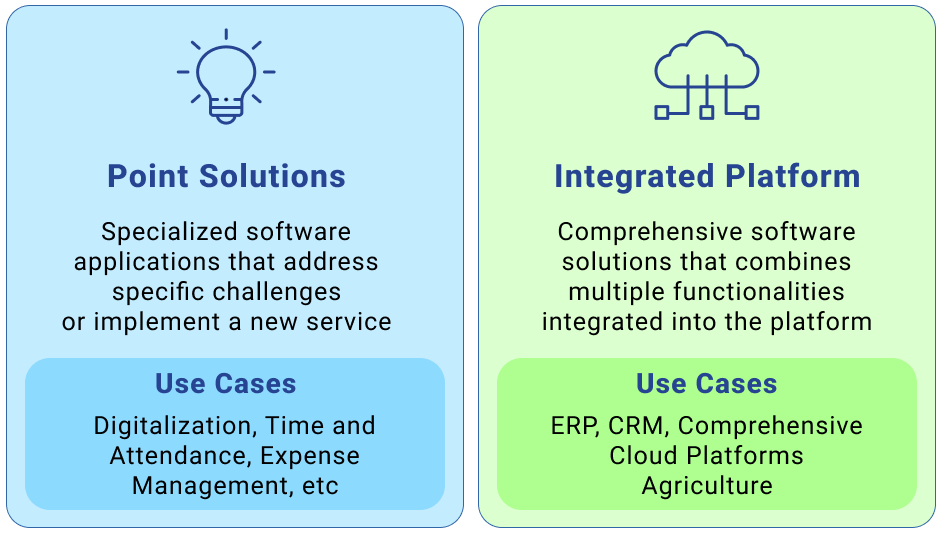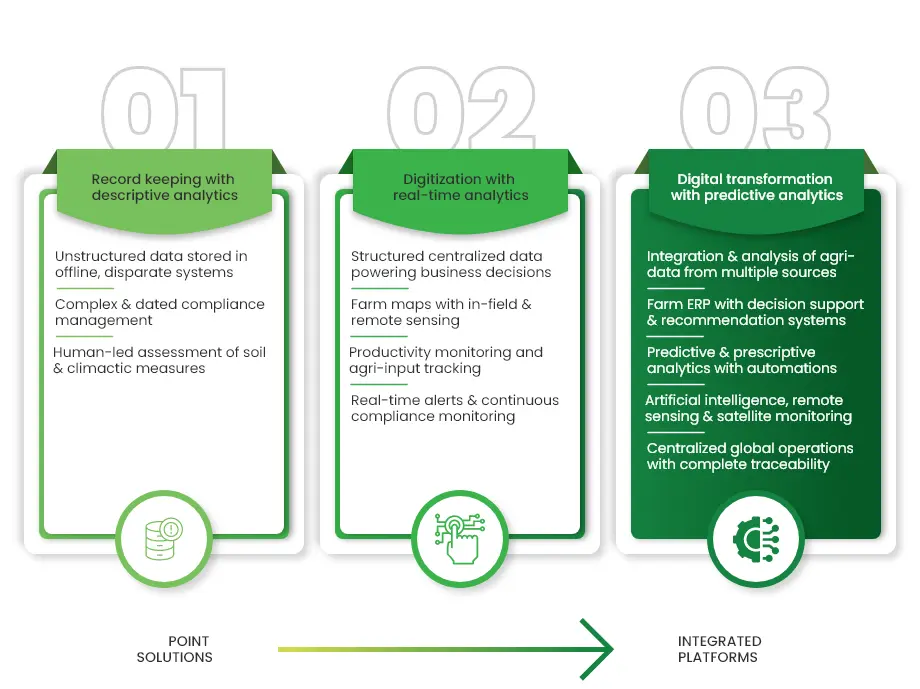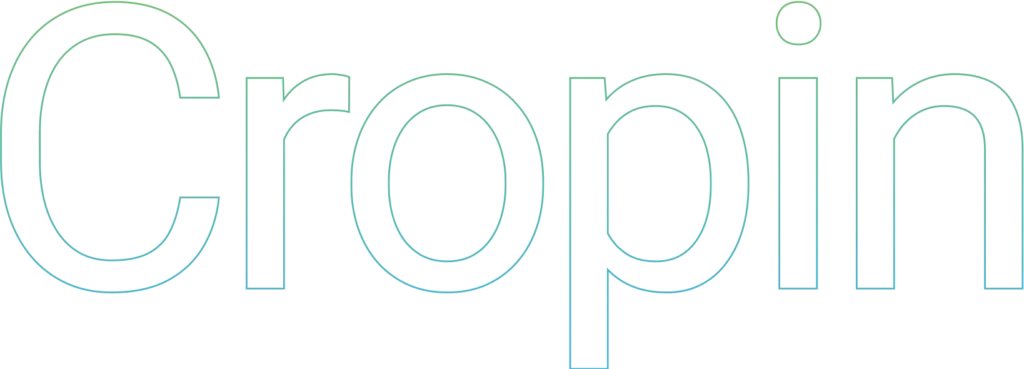The rise of point solutions

The limitations of point solutions
Overwhelming choice: The agtech market offers a staggering array of point solutions, but this abundance does not ease the process. It is a daunting task for the stakeholders to evaluate thousands of solutions, it requires significant time and energy. With the paradox of choice, assessing and pinpointing the most relevant solution suited to your unique needs becomes tough.
Scalability across regions: Point solutions are tailored to address today’s region-specific and/or crop value chain challenges. These are not adaptable across different regions and use cases, making scaling a real challenge. To stay ahead, stakeholders need to continuously seek new alternatives, adding complexity to the selection process.
Fragmented approach: Agriculture is an extremely interconnected value chain that cannot be managed efficiently by highly fragmented point solutions. Challenges in agriculture evolve from basic digitization and advance towards more sophisticated artificial intelligence (AI) and machine learning (ML) requirements. Relying on fragmented point solutions leads to inefficiencies in development, change management, deployment and scaling. These solutions lack clean, contextualized data pipelines crucial for AI/ML solutions, demanding significant efforts and investments in cleaning and contextualizing data, thereby hampering the speed of developing and deploying predictive intelligence.
Integration hurdles: Point solutions address specific agricultural challenges. It often results in isolated piecemeal outcomes that lack a cohesive toolkit for the highly interconnected agriculture value chain. As enterprises have used, developed, or acquired diverse solutions, integrating systems and data is a complex task involving escalated cost overheads to maintain and manage. It is precisely here that point solutions buckle and fail.
Lack of holistic view: A holistic view of a challenge is absent when working with point solutions. There is no interconnected approach, no understanding of the bigger picture, forget about thinking outside the box, the box itself disappears. This leads to operational inefficiencies as comprehensive insights considering the entirety of a business are missing.
Management complexity: As the number of solutions increases, a requirement around managing them emerges. This involves extra costs beyond the explicit cost of the solution, extended turnaround times and increased resource allocation. Each point solution caters to unique functional or process-specific use cases. If you take this route, soon, you will have isolated silos within different business divisions or regions. The result – operational inefficiencies and technology sprawl.
Interoperability & data loss: Point solutions often lack interoperability, leading to difficulties integrating data from various tools and resulting in a fragmented view of farm operations. The absence of templatization adds to the challenge of adapting these solutions to diverse farm needs during expansion, requiring additional time and effort. Importantly, their limited long-term suitability raises concerns about data loss, as these may struggle to manage and transfer data over time effectively.
Data is not democratized: Data is often compartmentalized, preventing businesses from providing real-time data access to their employees at all levels. This siloed approach creates barriers between teams, hampers collaboration, and hinders innovation, productivity and decision-making. The pronounced mismatch between production and supply-demand dynamics is an evident illustration of this challenge. The downstream business processes in seed and consumer packaged goods (CPG) companies have yet to undergo digital transformation, limiting their potential for growth and efficiency. Such a transformation using point solutions cannot effectively use the abundant data reservoir obtained in the first mile.
But let’s introspect:
- How can we address the inefficiencies posed by the surge of point solutions in agriculture?
- What steps can we take to ensure that technology in agriculture catalyzes holistic improvement rather than contributing to complexity and inefficiency?
- Are there opportunities for greater alignment and synergy within the agricultural ecosystem?
- While we are unlocking innovations for today, are we being prepared for tomorrow?
Advance agriculture from point solutions to integrated platforms

Difference between point & integrated solutions
| Point Solution | Integrated Platform |
|---|---|
| Point Solutions address specific challenges, need separate integration, lack a holistic view, are cost-ineffective without economies of scale, and increase management complexities. |
Integrated platforms consolidate diverse solutions into a platform. provide a holistic view. streamline operations, and enhance costs and efficiency with a single maintenance team. |
| These are cost-effective and suitable for small agricultural businesses but struggle with limited automation and data collection. The collected data can’t be analyzed at scale by Al/ML solutions, as it is unstructured data and in silos. |
These being highly scalable are ideal for large businesses, They leverage cutting-edge technolo-gies and automate data collection. As data collected is structured, AV/ML solutions can analyze them at scale, |
| As it lacks adaptability across regions and use cases, users must continuously seek alternatives, increasing the complexity and technology sprawl. | Being seamlessly sealable for agricultural geographic expansion, it enables effortless transfer and application of knowledge across geographies or crops. |
The case for integrated platform in agriculture
Explore Cropin Cloud – our intelligent integrated agriculture platform
Frequently asked questions
What is a point solution?
What is an integrated platform?
Which is better - a point solution or an integrated platform?
How to decide which to use – Point Solution or Integrated Platform?
Here are some considerations when deciding whether a point solution or holistic approach is more beneficial for your organization:
Number of existing technologies
As businesses continue to add more applications and systems, leaders must assess their tech stacks and weigh the benefits of adding yet another solution. ROI of either option
While point solutions are generally more affordable and require less upfront costs, integrated platforms help reduce costs and IT resources. So, weigh your options accordingly.
Time needed to implement and maintain
While point solutions are much easier and faster to get up and running, consider how much time and resources might be needed to support the solution in the long term. Upgrades and support required in the future
Where will the organization be in a few years? Will the IT team still be able to leverage the solution to achieve future goals or will significant work be needed?








